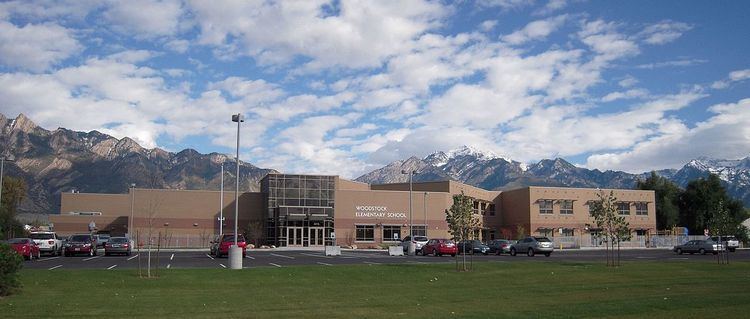Established 1906 Faculty 15.0 (on FTE basis) Enrollment 420 (as of 2010-11) Phone +1 385-646-5108 Founded 1906 | Principal Yvonne Pearson Grades Early 3s Preschool-6 Mascot Woodstock Wolverine District Granite School District | |
 | ||
School type Public elementary school Address 6015 S 1300 E, Murray, UT 84121, USA Similar Mill Creek Elementary School, John C Fremont Elementa, Parkside Elementary School, Highland Park Elementa, Midvalley Elementary School | ||
Woodstock Elementary School is a public primary school in Murray, Utah, USA, serving students in grades PS-6. The school is part of the Granite School District, with 75% of admission based on the locations of students' homes and 25% based on School Choice. Founded in 1906 as 26 District School (or Greebville School), it originally served both primary and secondary students. The school has relocated and its physical structure been replaced several times during its history, but has maintained the Woodstock name.
Contents
History
In 1905 the schools of Salt Lake County were consolidated into three districts: Jordan, Granite, and Murray. This consolidation was effected largely through the efforts of John W. Smith, the last superintendent of Salt Lake County.
In 1906 the newly formed districts needed 105 additional classrooms. The state would not bond indicating it was the responsibility of each district, but the districts didn't have enough money. A company in New York, saw the potential here and bought the bonds to finance the new buildings. A new high school was built in each district.
Woodstock Elementary School was completed in 1906 at a cost of $18,913.00 on a three-acre plot of land that had been purchased for $1,600.00, making the total cost of $20,513.00. It was a two-story brick building with six large classrooms. At the front of each classroom, there was a door for the teacher. Near the rear of the classroom, there were two separate adjacent doors, one for the boys and one for the girls. A five-feet high wooden partition extended out into the corridor from between these two doorways, running along the corridor away from the outside wall nearly the length of the classroom. Thus, one section of the corridor provided the girls with their coat hall, and the other section provided the boys with theirs. Two rows of hooks were located on both the partition and the corridor wall for the students to hang their wraps on and during inclement weather they left their galoshes on the floor next to the wall.
The building had hard wood floors and beautifully varnished scrollwork and woodwork throughout the building. Twice each year, the floor was mopped by women hired specifically for this purpose using big long mops, boiling water, and strong soap. The first mopping was done before the beginning of the school year and the second during Christmas break. After the mopping was completed each time, a coat of linseed oil was applied to the floors. The floors were swept during the year by using a mixture of linseed oil and sawdust as a sweeping compound. The school received its name from the novel Woodstock, written by Sir Walter Scott in 1826. Its setting was a hunting lodge in Woodstock, England. The name was originally suggested by David W. Moffett, an educator in the Granite School District.
Woodstock Elementary would replace the old District 26 School which was situated on the west side of 1300 East Street, across from the present school. District 26 school was referred to as the Greebville School. Edward Erastus Howe was the first principal of Woodstock from 1906 to 1916. He also taught in the 26 District School. Each Monday morning, E. E. Howe would go by horse and buggy down to the trolley line at 5900 South State Street to pick up Miss Cuddy, Miss Stone, and Miss Dorius. After school each Friday he would take them back to the trolley line so they could go to Salt Lake City. The teachers would board with some of the families during the weekdays. Miss Cuddy boarded with a Turner family. E. E. Howe and Miss Cuddy were married June 25, 1913.
Woodstock originally taught grades Kindergarten through Ninth Grade. Noted inventor Philo Farnsworth taught ninth grade at the school in the 1920s. With the construction of Junior High Schools, Woodstock was organized to handle grades Kindergarten through Sixth.
Current
Sometime prior to 1949 a third level was added. The addition made the school a three story building.
Woodstock elementary would later acquire land from the Felix Delliskave family and other farmers to extend the playground to its current extent. In 1959, an addition was added to the original structure that included 12 classrooms and a multi-purpose room. The 1906 structure was deemed structurally unsound, and was torn down in the 1970s. The structure was replaced with a library, multipurpose room, and a few classrooms.
In the early 2000s, the school was threatened with closure due to budgetary and enrollment concerns. The community rallied to keep the school alive, and the Granite School District Board voted to keep Woodstock open. In August 2011, the fifth Woodstock school building opened its doors. The two-story building features a gymnasium, cafeteria, two large group rooms, a spacious food service area, parking, and tile floor patterns designed by the children of Woodstock.
